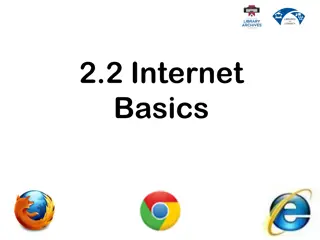Essential Web Workers for Concurrent Processing
Web workers in JavaScript allow for concurrent processing in the background, enhancing webpage performance. Learn how to create, manage, and leverage web workers efficiently, optimizing tasks and improving user experience. Explore testing browser support and creating scripts for effective background tasks.
Download Presentation

Please find below an Image/Link to download the presentation.
The content on the website is provided AS IS for your information and personal use only. It may not be sold, licensed, or shared on other websites without obtaining consent from the author.If you encounter any issues during the download, it is possible that the publisher has removed the file from their server.
You are allowed to download the files provided on this website for personal or commercial use, subject to the condition that they are used lawfully. All files are the property of their respective owners.
The content on the website is provided AS IS for your information and personal use only. It may not be sold, licensed, or shared on other websites without obtaining consent from the author.
E N D
Presentation Transcript
LEARNING OBJECTIVES How a Web worker is essentially a JavaScript routine that performs concurrent processing within the background How to create and use a Web worker within an HTML page How to start, stop, and terminate a Web worker What the objects a Web worker can and cannot access
UNDERSTANDING WEB WORKERS In general, to perform concurrent processing, an operating system quickly switches between tasks, giving the perception that multiple actions are occurring at the same time. Given that today s processors are often multicore, the operating system can assign each core processor a task to perform. Developers refer to such tasks as a thread of execution. Each thread contains the instructions the processor executes to accomplish a specific task. A Web worker is a JavaScript routine that allows a webpage to perform similar concurrent processing. In general, a webpage uses a specific JavaScript file that contains the code the worker performs to accomplish a task. The webpage that uses the worker creates a worker object, which begins to perform its processing within the background. As the worker completes its processing, it sends a message to the webpage. The webpage, in turn, can use the message as appropriate. The Web worker does not impact the webpage performance because it runs in the background.
TESTING FOR BROWSER WEB WORKER SUPPORT <!DOCTYPE html> <!DOCTYPE html> <html> <html> <head> <head> <script> <script> function function testWorkerSupport testWorkerSupport() () { { if ( if (typeof typeof(Worker) != "undefined") (Worker) != "undefined") alert("Web Workers Supported"); alert("Web Workers Supported"); else else alert("Web Workers Not Supported"); alert("Web Workers Not Supported"); } } </script> </script> </head> </head> <body <body onload onload=" ="testWorkerSupport testWorkerSupport();"> </body> </body> </html> </html> ();">
CREATING A WEB WORKER SCRIPT A Web worker is essentially a JavaScript routine that performs specific processing as a background task. A background task is a thread of execution the processor executes during its free time or using an available core processor. The following JavaScript file, Time.js, defines a function that wakes up every second to determine the current time. The code then uses the postMessage function to send the time back to the webpage that is using the worker: function function myTimer { { var var date = new Date(); date = new Date(); vartimeStr vartimeStr = = date.toLocaleTimeString date.toLocaleTimeString(); (); postMessage postMessage( (timeStr timeStr); ); setTimeout setTimeout(myTimer,1000); (myTimer,1000); } } myTimer() () setTimeout setTimeout(myTimer,1000); (myTimer,1000);
USING THE WEB WORKER <!DOCTYPE html> <!DOCTYPE html> <html> <html> <head> <head> <script> <script> var var worker; worker; function function startWorker startWorker() () { { if ( if (typeof typeof(Worker) != "undefined") (Worker) != "undefined") { { worker = new Worker("time.js"); worker = new Worker("time.js"); worker.onmessage worker.onmessage = function(event) { } } else else alert("Web Workers Not Supported"); alert("Web Workers Not Supported"); } } = function(event) { showTime showTime(event); }; (event); }; function function showTime showTime(event) { { document.getElementById document.getElementById('clock'). } } (event) ('clock').innerHTML innerHTML = = event.data event.data; ;
CONTINUED function function StopWorker StopWorker() () { { if (worker) if (worker) { { worker.terminate worker.terminate(); (); worker = null; worker = null; } } } } function function StartWorker StartWorker() () { { if (! worker) if (! worker) startWorker startWorker(); (); } } </script> </script> </head> </head> <body <body onload onload=" ="startWorker <div id="clock" style="font <div id="clock" style="font- -size:100px"></div> < <img img src src="hourglass.jpg"> ="hourglass.jpg"> < <br br/> /> <button <button onclick onclick=" ="StopWorker StopWorker()">Stop Worker</button> <button <button onclick onclick=" ="StartWorker StartWorker()">Start Worker</button> </body> </body> </html> </html> startWorker();"> ();"> size:100px"></div> ()">Stop Worker</button> ()">Start Worker</button>
LOOKING AT A SECOND EXAMPLE The following HTML file, FamousQuotes.html, displays a photo, a name, and a quote. Every 10 seconds, the file changes its content based on the worker input.
QUOTES.JS WORKER FILE var var index = 0; index = 0; var var quotes = new Array('Lincoln; Lincoln.jpg; Better to remain silent and be thought a quotes = new Array('Lincoln; Lincoln.jpg; Better to remain silent and be thought a fool than to speak out and remove all doubt.', fool than to speak out and remove all doubt.', 'Einstein; Einstein.jpg; A person who never made a mistake never tried 'Einstein; Einstein.jpg; A person who never made a mistake never tried anything new.', anything new.', 'Washington; Washington.jpg; Be courteous to all, but intimate with few, 'Washington; Washington.jpg; Be courteous to all, but intimate with few, and let those few be well tried before you give them your confidence.'); and let those few be well tried before you give them your confidence.'); function function myTimer { { postMessage postMessage(quotes[index]); (quotes[index]); index += 1; index += 1; if (index == 3) if (index == 3) index = 0; index = 0; setTimeout setTimeout(myTimer,10000); (myTimer,10000); } } myTimer() () setTimeout setTimeout(myTimer,500); (myTimer,500);
FAMOUSQUOTES.HTML <!DOCTYPE html> <!DOCTYPE html> <html> <html> <head> <head> <script> <script> var var worker; worker; function function startWorker startWorker() () { { if ( if (typeof typeof(Worker) != "undefined") (Worker) != "undefined") { { worker = new Worker("Quotes.js"); worker = new Worker("Quotes.js"); worker.onmessage worker.onmessage = function(event) { } } else else alert("Web Workers Not Supported"); alert("Web Workers Not Supported"); } } = function(event) { showQuote showQuote(event); }; (event); }; function function showQuote showQuote(event) { { var var name = name = event.data.substring event.data.substring(0, document.getElementById document.getElementById('name'). (event) (0, event.data.indexOf event.data.indexOf(';')); ('name').innerHTML innerHTML = name; (';')); = name; varimagefile varimagefile = = event.data.substring event.data.substring( (event.data.indexOf document.getElementById document.getElementById('photo'). ('photo').src event.data.indexOf(';')+1, src = = imagefile imagefile; ; (';')+1, event.data.lastIndexOf event.data.lastIndexOf(';')); (';')); var var quote = quote = event.data.substring event.data.substring( (event.data.lastIndexOf document.getElementById document.getElementById('quote'). ('quote').innerHTML event.data.lastIndexOf(';')+1); innerHTML = quote; = quote; (';')+1); } }
CONTINUED function function StopWorker StopWorker() () { { if (worker) if (worker) { { worker.terminate worker.terminate(); (); worker = null; worker = null; } } } } function function StartWorker StartWorker() () { { if (! worker) if (! worker) startWorker startWorker(); (); } } </script> </script> </head> </head> <body <body onload onload=" ="startWorker <div id="name" style="font <div id="name" style="font- -size:100px"></div> < <img img id="photo" id="photo" src src="lincoln.jpg"> ="lincoln.jpg"> <div id="quote" style="font <div id="quote" style="font- -size:48px"></div> < <br br/> /> <button <button onclick onclick=" ="StopWorker StopWorker()">Stop Worker</button> <button <button onclick onclick=" ="StartWorker StartWorker()">Start Worker</button> </body> </body> </html> </html> startWorker();"> ();"> size:100px"></div> size:48px"></div> ()">Stop Worker</button> ()">Start Worker</button>
OBJECTS A WEB WORKER CAN AND CANT ACCESS Web workers are meant to perform complex processing within the background. Web workers cannot access the following objects because they reside in an external JavaScript file,: window object document object parent object localStorage or sessionStorage Web workers can, however, access the following: location object navigation object application cache XMLHTTPRequest
SUMMARY With many computers now using multicore processors, the use of threads to implement concurrent processing is becoming quite common. In this chapter, you learn how to use Web workers to perform background processing for a webpage. As you learned, a Web worker is essentially a JavaScript routine that performs specific processing. Because the Web worker performs its processing in the background, the worker does not impact the webpage performance.























